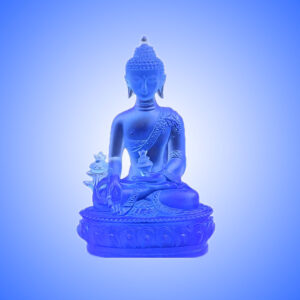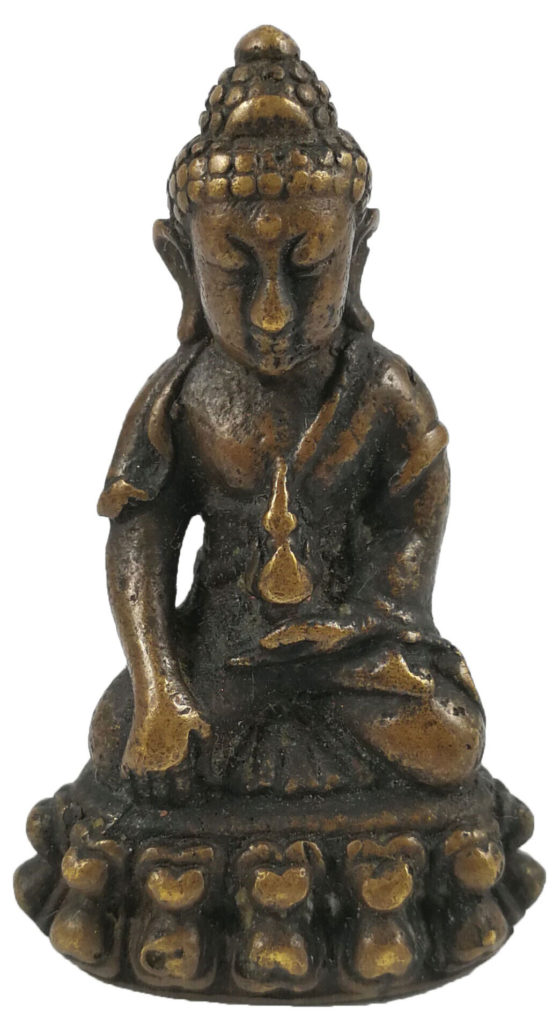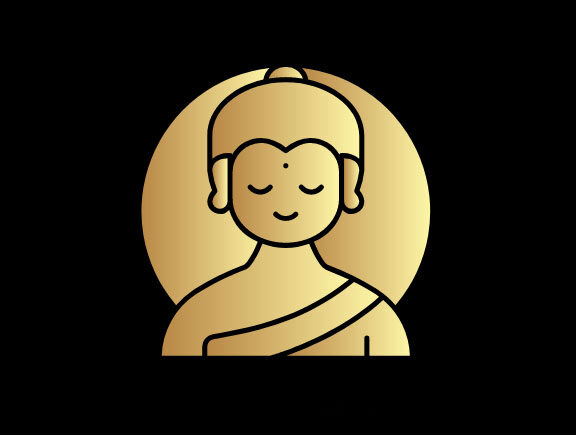
| Namo bhagavate bhaisajyaguru vaiduryaprabharajaya tathagataya arhate samyaksambuddhaya tadyatha: Om bhaisajye bhaisajye bhaisajya-samudgate Svaha |
Meaning:
“Homage to the Blessed One, The Master of Healing, The King of Lapis Lazuli Radiance, The One Thus-Come, The Worthy One, The Fully and Perfectly Awakened One, thus: ‘Hail! Appear, O Healer, O Healer, O Great Healer, O King of Healing!’ ”
The Twelve Vows
- I vow that from now on, when I have attained Supreme Enlightenment, beams of light will shine outward from my body, lighting up all realms with my radiance. Moreover, I will allow all sentient beings to become enlightened.
- I vow that from now on when I have attained Supreme Enlightenment, the lights from my body will illuminate the healing effects of lapis lazuli over great distances. The lights will make conscious the souls and minds of the sentient beings, allowing them to continue in their journey.
- I vow that from now on, when I have attained Supreme Enlightenment; I will supply all sentient beings with an unlimited amount of material goods for their needs.
- I vow that from now on, when I have attained Supreme Enlightenment, I will locate all who practice religious ways to the path of enlightenment. Similarly, I will settle those who follow the disciple and Pratyaka Buddha ways onto the Great Vehicle path.
- I vow that from now on, when I have attained Supreme Enlightenment, I will help every sentient who follows my philosophy concerning the Dhamma to master the Three Pure Precepts. Those who had broken the Precepts would return to their purity upon hearing my name and not descend upon the evil path.
- I vow that from now on, when I have attained Supreme Enlightenment, sentient beings born with defects physically or mentally will acquire an exquisite body. Furthermore, they will be free of sickness and agony.
- I vow that from now on, when I have attained Supreme Enlightenment, I will help relieve the needy and the sick from all illnesses upon hearing my name, and they will eventually realize Supreme Enlightenment.
- I vow that from now on when I have attained Supreme Enlightenment, those women unsatisfied with their affliction and who wish to be reborn as men will all achieve their desired rebirth upon hearing my name. Additionally, they will be blessed with great features and eventually realize Supreme Enlightenment.
- I vow that from now on, when I have attained Supreme Enlightenment; I will help all sentient beings depart from the evil path and lead them to enlightenment, should they be trapped in the wrong belief.
- I vow that from now on, when I have attained Supreme enlightenment; I will help all sentient beings that are oppressed and are suffering physically and mentally to be unrestrained upon hearing my name because of my merits and virtues.
- I vow that from now on when I have attained Supreme Enlightenment, I will help to relieve those suffering from extreme thirst and are on the edge of doing evil deeds to survive. I will appease them with delicious food and drink. Lastly, I will set them in peace and happiness through Dhamma practices.
- I vow that from now on when I have attained Supreme Enlightenment, sentient beings suffering from hypothermia, hyperthermia, and insect bites due to the lack of proper clothing will receive appropriate clothing upon hearing my name.
Medicine Buddha
Medicine Buddha (Bhaisajyaguru), formally known as Bhaisajyaguruvaiduryaprabharaja, “Medicine Master and King of Lapis Lazuli Light”, is the Medicine Buddha in Mahayana Buddhism. Bhaisajyaguru is venerated in Mahayana Buddhism because of its spiritual and physical healing powers. The earliest findings of the Bhaisajyaguru are in the Bhaisajyaguruvaiduryaprabharaja Sutra, also known as the Medicine Buddha Sutra, which was discovered in the ancient Gandhara kingdom (current Pakistan and Afghanistan).
The Medicine Buddha almost always holds an alms bowl or medicine jar in his left hand. In Tibetan Medicine Buddha images, a myrobalan plant may grow in the bowl. Bhaisajyaguru is often portrayed sitting on a double-tier lotus throne with his right hand reaching out, which signifies its readiness to give its blessings and answer prayers. The Medicine Buddha is often seen holding a pagoda in Chinese depictions.
Lapis lazuli, a deep blue color, is almost certainly used to depict Bhaisajyaguru in Tibetan Thangka and iconography. It might appear as an aura surrounding the Buddha or Bhaisajyaguru. The lapis lazuli color has a purifying and strengthening effect on those who look at it. One should chant and visualize the image of the Buddha for more effectiveness; imagine the Mantra and aura emanating from Bhaisajyaguru. Since ancient times, it has been said that the Buddha’s image or name alone can bring about indescribable benefits.
The Medicine Buddha mentioned in the eponymous Bhaisajyaguruvaiduryaprabharaja Sutra that he made twelve vows while still a Bodhisattva. While in meditation (samadhi) state, Bhaisajyaguru spoke the Medicine Buddha Mantra. According to the Medicine Buddha Sutra, one should chant the Mantra 108 times with a cup of water and allow the sick ones to drink it, which will help them recover faster.

Phra Kring’s appearance
Phra Kring was made as a Bhaisajyaguru’s image. Phra Kring Yai (large amulet mold) originated in China. It is the only prominent Phra Kring mold that was made outside of Thailand that is popular in the amulet community. Around 1400 B.E., Phra Kring’s image was first depicted, and ever since, it has served as the standard. Its image typically shows it sitting on a two-layer lotus base with seven petals each. The Phra Kring name derives from the “Kling” sound that it produces when shaken. It is a common belief that hearing the ringing sound could bring one good luck and harmony, thus improving one’s overall spiritual health. The ringing sound will reverberate to the Medicine Buddha, and he will bless and protect the user from all dangers.
Phra Kring’s image is closely associated with other Buddha artistry from Cambodia and China. In Thai, Phra Kring means “Ringing Buddha,” and it is pronounced similarly to its English counterpart “, ring,” which derives from the sound of the ringing bell. Phra Kring’s hollow body contains a ball bearing that produces a ringing sound when shaken. The intention is to make one relate to the critical characteristics of the three marks of existence in Buddhism: impermanence(anicca), suffering(dukkha), and non-self(anattā). Currently, Phra Kring’s “Pawares” from Wat Suthat have the most value and are highly prized by collectors.
Here are a few hand-picked articles for you to read next:
